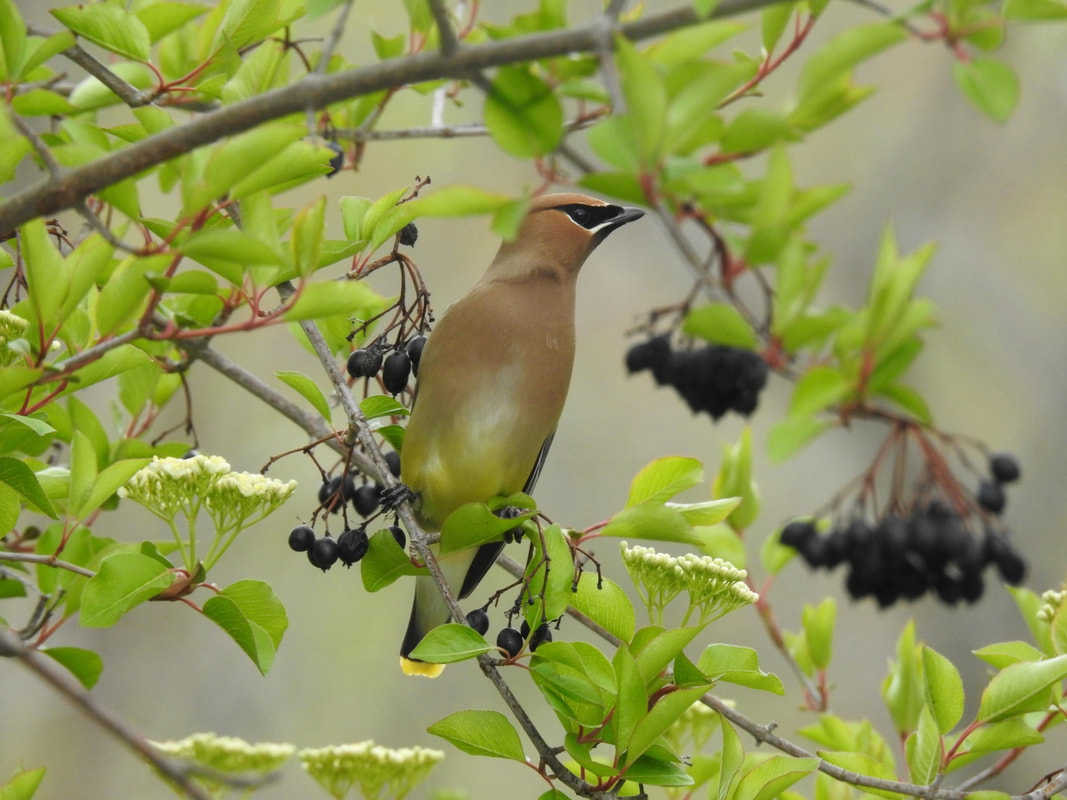 Cedar waxwing; Credit: Deanne Lawrence Cedar waxwing; Credit: Deanne Lawrence Sycamore Grove Farm, Madison County The Cedar waxwing (Bombycilla cedrorum)is a social bird that lives in Virginia all year round. Their population increases during the winter with migration from the north. Mostly seen in flocks, cedar waxwings move around looking for berries, their food of choice. They eat serviceberry, cedar berry, strawberry, mulberry, dogwood and raspberry. These birds eat in shifts, with one group eating first and then moving out of the way for the next group to come in. This is very different than most birds, who just try to grab what they can individually. Cedar waxwings are a major dispersing agent of seeds of various fruit species as their digestive system is so fast that the seed is expelled intact. They can also be responsible for significant damage to commercial fruit farms, which consider them a pest. During the summer before berries are ripe, cedar waxwings eat insects, including mayflies, dragonflies and stoneflies, which they catch on the wing. In late summer and fall, cedar waxwings have been observed eating overripe berries that have fermented in the sun, which causes the birds to become intoxicated. Because they can gorge on fruit, there have been instances when individual birds have actually died from intoxication. While I have never seen this “drunken” behavior, last year I saw a flock clean every single berry off of one of our large cedar trees that was laden with ripe berries. The habitat that attracts cedar waxwings includes woodlands of all types, particularly areas along streams. They are also observed in old fields and grasslands, farms, orchards, and suburban gardens that have fruiting trees or shrubs. Cedar waxwings spend much of their time in the tops of tall trees. Our farm is bordered by trees on two sides and the farm across the street is wooded – so we often see cedar waxwings in flight and in our trees. They are vulnerable to window collisions and being struck by cars as the birds feed on fruiting trees along the roadside. Cedar waxwings are “serial monogamous” – they form matings bonds that last one breeding season (from the end of spring through late summer). They reach reproductive maturity at one year and can live up to eight years in the wild. While categorized as a song bird, the National Wildlife Federation notes “their singing voices are nothing to sing about.” Their song is a high-pitched “sseee” call. The “waxwing” in its name refers to the brilliant-red wax droplets on their feathers which appear from after the second year. Scientists are not sure what the exact function is of brightly-color tips but assume it may be used to attract mates. So keep your eye out for these beautiful birds – they are fast flyers (up to 25 mph) so you just might miss them as they fly by. Happy birding! Charlene
0 Comments
Your comment will be posted after it is approved.
Leave a Reply. |
Have a blog or blog idea?
Let us know (click) Other Blogs
VA Native Plant Society - click Brenda Clement Jones - click John Muir Laws' Blog - click Megan's Nature Nook - click Categories
All
Archives
September 2023
Blog Administrator:
Kathleen A. VMN since 2018 |